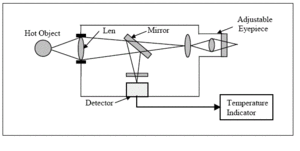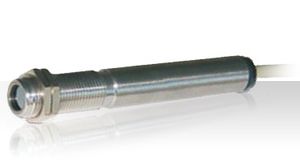Pyrometers
Pyrometer is a non-contacting device that intercepts and measures thermal radiation, a process known as pyrometry. This device can be used to determine the temperature of an object's surface. The word pyrometer comes from the Greek word for fire, "πυρ" (pyro), and meter, meaning to measure. Pyrometer was originally coined to denote a device capable of measuring temperatures of objects above incandescence i.e. objects bright to the human eye.
History
The potter Josiah Wedgwood invented the first pyrometer to measure the temperature in his kilns.Modern pyrometers became available when the first disappearing filament pyrometer was built by L. Holborn and F. Kurlbaum in 1901.This device superimposed a thin, heated filament over the object to be measured and relied on the operator’s eye to detect when the filament vanished.The object temperature was then read from a scale on the pyrometer. The temperature returned by the vanishing filament pyrometer and others of its kind, called brightness pyrometers, is dependent on the emissivity of the object. With greater use of brightness pyrometers, it became obvious that problems existed with relying on knowledge of the value of emissivity. Emissivity was found to change, often drastically, with surface roughness, bulk and surface composition, and even the temperature itself. To get around these difficulties, the ratio or two-color pyrometer was developed. They rely on the fact that Planck's law, which relates temperature to the intensity of radiation emitted at individual wavelengths, can be solved for temperature if Planck’s statement of the intensities at two different wavelengths is divided. This solution assumes that the emissivity is the same at both wavelengths and cancels out in the division. This is known as the gray body assumption. Ratio pyrometers are essentially two brightness pyrometers in a single instrument. The operational principles of the ratio pyrometers were developed in the 1920s and 1930s, and they were commercially available in 1939.
As the ratio pyrometer came into popular use, it was determined that many materials, of which metals are an example, do not have the same emissivity at two wavelengths.For these materials, the emissivity does not cancel out and the temperature measurement is in error. The amount of error depends on the emissivities and the wavelengths where the measurements are taken.Two-color ratio pyrometers cannot measure whether a material’s emissivity is wavelength dependent. To more accurately measure the temperature of real objects with unknown or changing emissivities, multiwavelength pyrometers were envisioned at the US National Institute of Standards and Technology and described in 1992.Multiwavelength pyrometers use three or more wavelengths and mathematical manipulation of the results to attempt to achieve accurate temperature measurement even when the emissivity is unknown, changing, and different at all wavelengths.
Applications
Pyrometers are suited especially to the measurement of moving objects or any surfaces that can not be reached or can not be touched.
Smelter Industry
Temperature is a fundamental parameter in metallurgical furnace operations. Reliable and continuous measurement of the melt temperature is essential for effective control of the operation. Smelting rates can be maximized, slag can be produced at the optimum temperature, fuel consumption is minimized and refractory life may also be lengthened. Thermocouples were the traditional devices used for this purpose, but they are unsuitable for continuous measurement because they rapidly dissolve.
Over-the-bath Pyrometer
Salt bath furnaces operate at temperatures up to 1300 °C and are used for heat treatment. At very high working temperatures with intense heat transfer between the molten salt and the steel being treated, precision is maintained by measuring the temperature of the molten salt. Most errors are caused by slag on the surface which is cooler than the salt bath.
Tuyere Pyrometer
The Tuyere Pyrometer is an optical instrument for temperature measurement through the tuyeres which are normally used for feeding air or reactants into the bath of the furnace.
Steam boilers
A steam boiler may be fitted with a pyrometer to measure the steam temperature in the super heater.
Hot Air Balloons
A hot air balloon is equipped with a pyrometer for measuring the temperature at the top of the envelope in order to prevent overheating of the fabric.
Pyrometry of gases
Pyrometry of gases presents difficulties. These are most commonly overcome by using thin filament pyrometry or soot pyrometry. Both techniques involve small solids in contact with hot gases.

